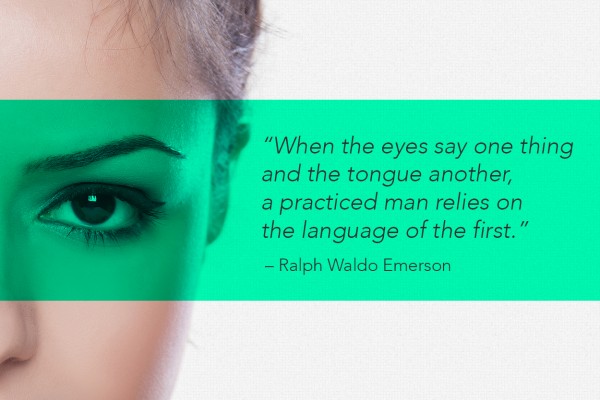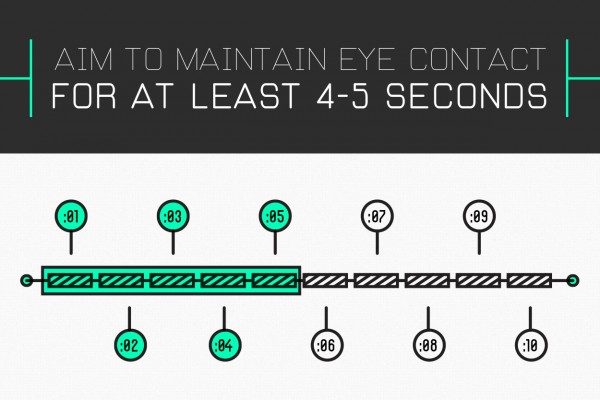“As any speaker will tell you, when you address a large number of people from a stage, you try to make eye contact with people in the audience to communicate that you’re accessible and interested in them.” – Simon Mainwaring
You may already be aware of the importance of eye contact; literature, debate class, and lecturing mothers have reinforced its importance throughout the ages. For example, the Bible verse Matthew 6:22 says: “The eye is the lamp of the body.” There is also the old expression: “eyes are the window to the soul,” which was thought to originate from Roman philosopher Cicero (106- 43 B.C.), who said: “Ut imago est animi voltus sic indices oculi,” which roughly translates to “the face is a picture of the mind and the eyes are its interpreter.
We know that it matters, but now the question becomes: why is it so important? And in the context of a presentation or public speech, how can eye contact be wielded properly during a talk to enhance your connection with the audience?
How it Works
Our vision helps us make sense of the world. According to the Social Science Research Network, 65% of us are visual learners. Our eyes are also incredibly powerful and sophisticated, with light sensitivity that is ten million times greater than any current film camera yet designed. When electrical impulses from eye arrive in the visual cortex of the brain, the brain is able to almost instantaneously interpret these signals. Similarly, if the eyes see something that the brain registers as threatening (a rhino running towards you, for instance), this data is quickly sent to a special reflex system that allows you to react before you have time to process the information elsewhere.
When someone makes direct eye contact with you, a combination of two things occur: the social cue of eye contact is added with the sudden movement of the motion which grabs your attention. Researchers have found that these two independent elements work together and increase engagement. No sudden movement means there is no powerful social cue. No social cue triggered means that the movement is not as valuable on its own.
From the same study: “The researchers found that reaction times were shorter when the letter was on the forehead of a face that suddenly gazed directly at the participants, affirming what many of us experience every day—direct eye contact is a powerful thing. Moreover, moving faces capture attention more strongly than static faces. When the eye contact and motion are combined, the result is even more profound.” (Source, University of Toronto)
The power of these social cues delivered when eye contact is made between two people starts at birth. In 2002, researchers published in Developmental Psychology discovered that babies would follow the direction of people’s eyes rather than their heads. Even more than this, researchers at MIT found that four-month-olds could more easily recognize a person if they had made direct eye contact with them.
In group settings and for speakers, eye contact can increase participation by making individuals feel more included. Dr. Roel Vertegaal published a piece in 2002 which claimed that the amount of eye contact a person received during a conversation proportionally affected how much they chose to participate during the activity. “Two conditions were studied: synchronized (where eye contact is made while the subject is speaking) and random contact, received at any time in the conversation. The Queen’s study showed that the total amount of gaze received during a group conversation is more important than when the eye contact occurs.” (Source, Science Daily)
Beyond participation, eye contact has the power to make you and your message more memorable, in the same way that four-month-olds applied recognition to eye contact. A study between the University of Wolverhampton and Stirling discovered that viewers remembered a speaker better if they looked into the directly into the camera at least 30% of the time during a speech.
However, eye contact can become less persuasive when used improperly. Extensive eye contact can send the wrong message or be intimidating when the speaker is opposed to your own viewpoint.
“According to Julia Minson of the Harvard Kennedy School of Government, co-lead researcher of the studies, the findings highlight the fact that eye contact can signal very different kinds of messages depending on the situation. While eye contact may be a sign of connection or trust in friendly situations, it’s more likely to be associated with dominance or intimidation in adversarial situations.
So, while we might be tempted make the demand, “Look at me when I’m talking to you!” of a listener, this demand may have unintended consequences: “Whether you’re a politician or a parent, it might be helpful to keep in mind that trying to maintain eye contact may backfire if you’re trying to convince someone who has a different set of beliefs than you,” says Minson.” (Source, Psychological Science)
How can you properly use eye contact during a speech without coming across as adversarial or intimidating? And furthermore, how can you use eye contact to enhance the positive reactions it can incite, such as memorability and participation?
How To Use It
Since the most meaningful connections happen with direct eye contact, start by ignoring advice that recommends looking at people’s foreheads or off towards the back of the room. Here are a few other things to be mindful of and to help improve your eye-catching technique:
Focus on the Back – The people in the front of the room are easy targets, but aim to make contact with the people in the middle or back who need to be drawn into the conversation. This can make all of the difference between these listeners feeling included or left out of your speech.
Scan the Room – Let your eyes travel across the room from right to left, and back again from left to right. Your aim is not to rigidly stare front and center and make eye contact with a small group, but rather to let the audience know through body language that you are aware of everyone in the room and paying attention to all of their social cues.
Don’t Play Favorites – One way to eliminate the risk of being an intimidating or adversarial speaker is not to single out one person, or revisit them as you scan the room too often. This can have the effect of a preacher who knows all of your secrets during a Sunday sermon, and can terrify someone depending on your message.
Include Everyone – It might not be feasible depending on the size of your audience, but set a goal before you begin to make eye contact with everyone in the room at least one time during your talk.
4-5 Seconds – Spend a little bit more time than you normally would making eye contact with members of your audience. We recommend up to 4-5 seconds, which can also help slow down your speaking rate is you tend to rush by keeping you focused. If you are worried about losing your train of thought with a mental count of “one-Mississippi,” then time your eye contact by the length of a sentence.
Body Language – Don’t merely look with your eyes, engage your entire body by squaring yourself towards the listener. This will come across as a little more natural than merely turning your head, and can help you move around a bit if you tend to be a stiff speaker.
Start Immediately – Rather than spending the crucial first 30 seconds of your talk scanning the room for someone to make eye contact with, pick an individual before the presentation begins. Our natural instinct is to size-up a room, but it might cause a long enough distraction for you to forget your purpose.
Know When to Quit – If someone looks uncomfortable or turns away when you make eye contact, respect that they might not enjoy that level of directness, and don’t return to them as you scan the room. There will always be plenty of other people to win over without having to seem aggressive.
Don’t Look Down – If making meaningful connections is your goal, then refrain from looking at notes, the screen, or down at your feet. This will break the natural flow of scanning the room, and will make you seem disengaged.
When properly done, eye contact has the power to make your presentation memorable, persuasive, and engaging. Don’t neglect this crucial public speaking skill during your next big presentation.
Question: How can you be more mindful about making eye contact during a speech?



